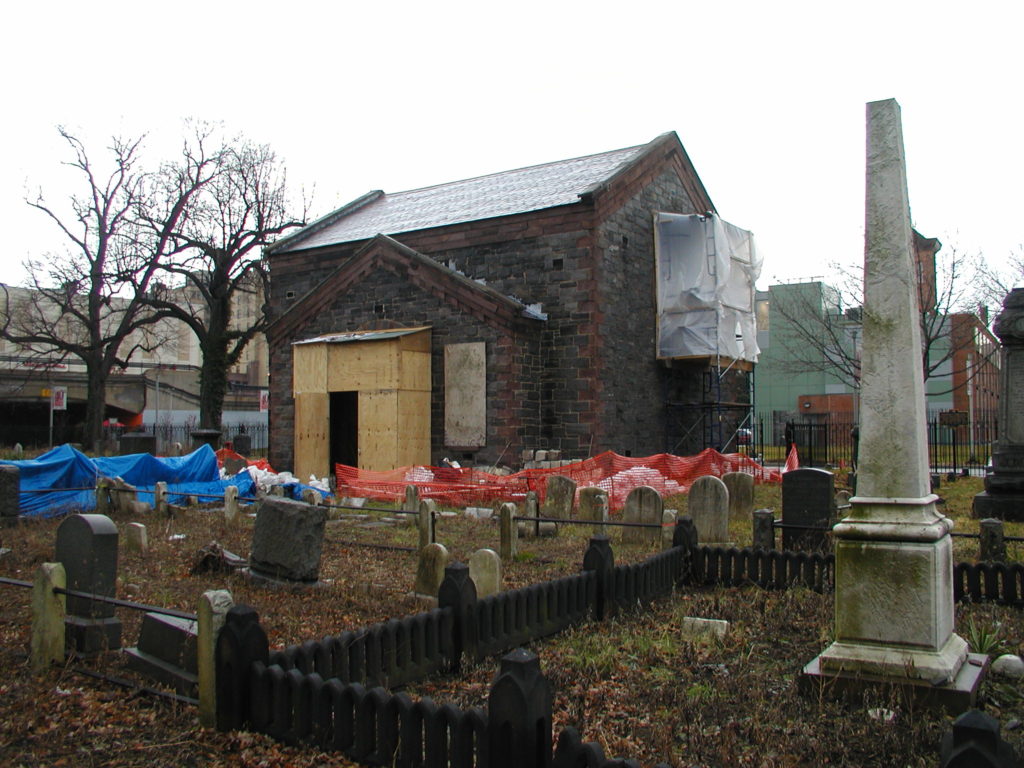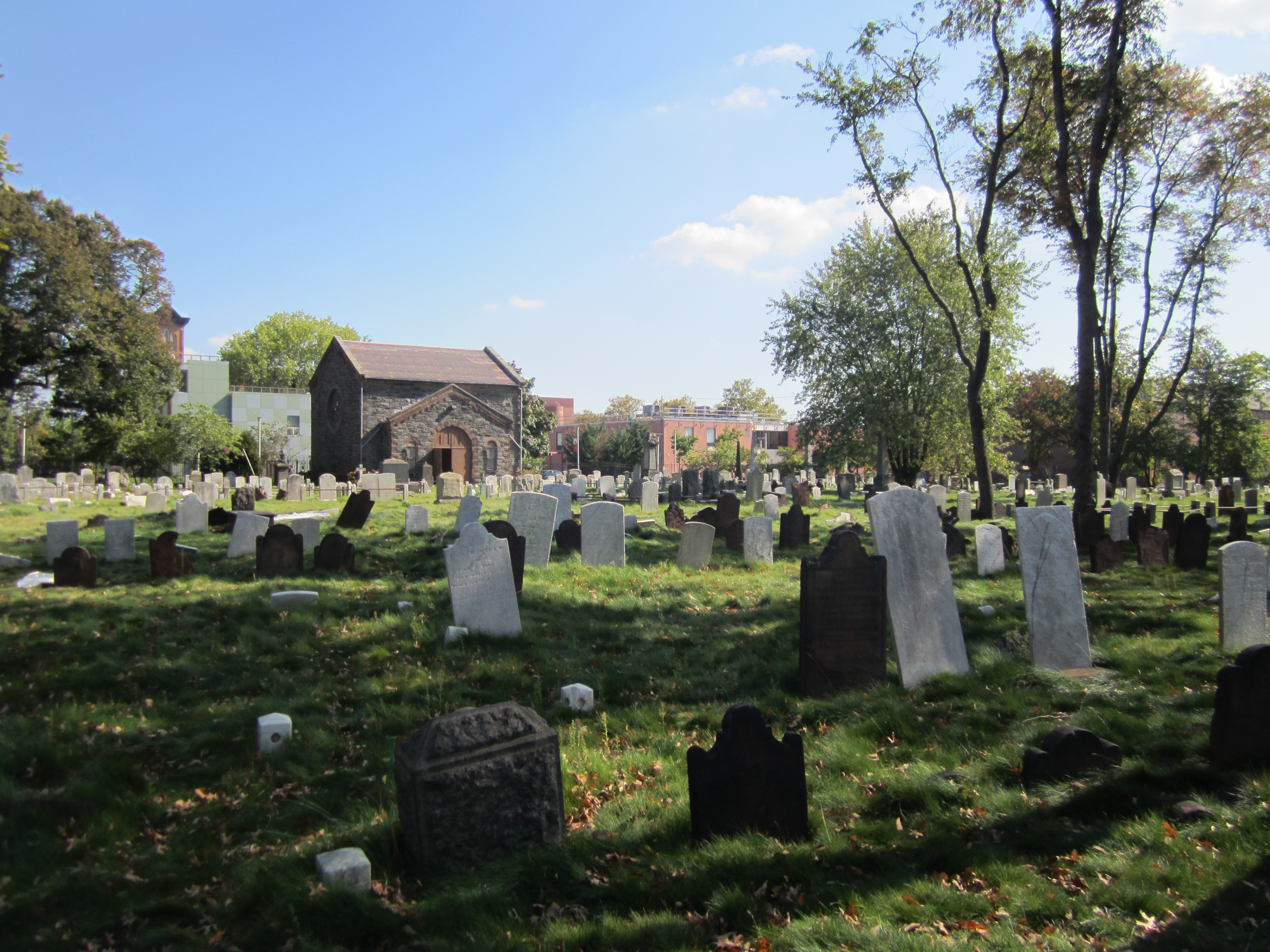Founded sometime prior to 1668, Prospect Cemetery is the oldest cemetery in Queens and one of the oldest burial grounds in the five boroughs. Originally serving as the early graveyard for the small town of Jamaica, it is one of the few remaining Colonial cemeteries in Queens. During the Revolutionary War, many of the men of Jamaica played a prominent role and were later buried in the cemetery.
Prospect Cemetery is the resting place of important figures in early New York City history. One example is Egbert Benson, a friend to Alexander Hamilton who acted as his secretary at the Constitutional Convention. Benson was a judge, State Attorney General and Congressman. Many Revolutionary War veterans, a great deal whom served with Skidmore’s Minutemen, are also buried here. Many descendants of those families fought in the Civil War, and were buried here as well.
During the first half of the 19th century, the early graveyard was increased in size as individuals purchased land surrounding the cemetery to lay out family plots. This extended the boundaries of the cemetery at its western and northern ends. Three acres were added in 1856 by wealthy New York City hardware merchant, Nicholas Ludlum, purchased from the Long Island Railroad to the eastern side of the cemetery.
Ludlum planned to improve and beautify the cemetery grounds. In 1857, at his own expense, he had a small chapel built as a memorial to his three daughters, each who had died at an early age. The Romanesque Revival-style chapel was built of random ashlar fieldstone with decorative light brown-colored sandstone trim at the eastern end of the graveyard and called the Chapel of the Three Sisters. The Chapel’s builder, Thomas Clary, is also buried on the grounds.
The Chapel of the Sisters is a symmetrical, one-story building approximately 40 by 40 feet and 25 feet high. At both the northern and southern facades is a large stained-glass rose window. When the Chapel was finished, it became the main entrance and focal point of Prospect Cemetery as the most visible structure on the property. On each wall of the Chapel, the names of each Ludlum sister is inscribed in addition to other inscriptions.
Prospect Cemetery is a valuable reminder of the village of Jamaica’s history and the important part its families played in shaping the early course of the United States. Grave markers range in style from the simple hand-carved fieldstone of Thomas Wiggins, dated 1728, to professionally carved brownstones with depictions of winged skulls and angels, to the striking marble and granite obelisks made fashionable in the 1800s.
It should be noted that the original front entrance to the burial ground was located on Beaver Road to the north. The older tombstones face eastward or westward on both sides of the old entrance to the graveyard. The newer tombstones all face eastward toward the entrance on 159th Street, formerly called Prospect Street.
Restoration Efforts

In 1999, several nonprofit organizations came together to address the vacant Chapel of the Sisters and overgrown cemetery grounds which had been in need of attention for many decades. The $2.4 million revitalization efforts included restoring the chapel, removing overgrown vegetation, conserving markers and re-landscaping the grounds utilizing public and private funds for the initiative.
The entire site was secured with new fencing and street improvements (lighting and new sidewalks) along 159th Street, the front edge of the Cemetery. By the end of 2008, the Chapel restoration included new heating, plumbing, and electrical systems, new wood windows and entry doors, new floors, and the reinstallation of the two rose windows. The Chapel was dedicated in 2008 as the Illinois Jacquet Performance Space, in memory of the famous jazz saxophonist who lived in Jamaica. After the upgrades and restoration efforts, the chapel began to be used as a small concert and event space.
In 2012, major vegetation removal was performed with the removal of 150 dead and invasive trees and 70 trees onsite were pruned. Pathways and family plots became evident that had been covered by brambles and vines over the years. In 2013, the grounds were cleared and planted with drought resistant grass. A GIS survey of over 2,000 markers was completed and conservation of 42 damaged markers was completed by 2014.
Colonial burial grounds, such as the older sections of Prospect Cemetery, provide us with a wealth of art, design, and significant information about earlier generations of Americans. The historic cemetery requires maintenance and upkeep of its markers and the Chapel building. The historic slate roof of the Chapel building is nearing the end of its serviceable life span. Join us today in our efforts to maintain the original Old Burial Ground of the Village of Jamaica.

